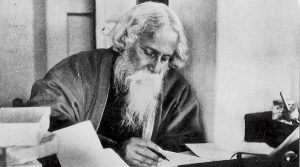
Written in the year 1894, coinciding with the birth of his son Shamindranath, Rabindranath Tagore’s composition Anandadhara bohichhe bhubone holds a significant place within Gitabitan. It was first sung as a Brahmasangeet at Kolkata’s Maharshi Bhaban during Magotsav that year. Sudhir Chanda mentions in Rabindranather Gaan Sanga-Anusanga, Anandadhara bohichhe bhubone is the only Rabindra sangeet set in Malkosh raga. Supposedly, the ideal time for this raga to be sung is around midnight. Perhaps it adds to the solemnity and depth of the song, aligning with the mood and essence of the Malkosh raga. The verse reflects Tagore’s endeavour to guide humanity towards discovering the euphoria of the universe. Such sentiments find resonance in his later letters, anthologised in Uma Dasgupta’s A History of Sriniketan. In a 1915 letter to an estate worker involved in the Sriniketan project aimed at rural upliftment, Tagore emphasised the need to infuse a note of joy into all endeavours.
Lyrics:
আনন্দধারা বহিছে ভুবনে,
দিনরজনী কত অমৃতরস উথলি যায় অনন্ত গগনে ॥
পান করি রবে শশী অঞ্জলি ভরিয়া–
সদা দীপ্ত রহে অক্ষয় জ্যোতি–
নিত্য পূর্ণ ধরা জীবনে কিরণে ॥
বসিয়া আছ কেন আপন-মনে, স্বার্থনিমগন কী কারণে?
চারি দিকে দেখো চাহি হৃদয় প্রসারি,
ক্ষুদ্র দুঃখ সব তুচ্ছ মানি
প্রেম ভরিয়া লহো শূন্য জীবনে ॥
English translation:
Joyous currents are flowing through the world.
Day and night, nectar spills into the infinite sky.
The Sun and the Moon savour a palm-full of this elixir.
An eternal flame emanates undying radiance —
The earth is perennially adorned, in illuminating life force
Why are you sitting confined within your own thoughts?
What is the reason for being absorbed in oneself?
Look around in all directions, with an extended heart,
Consider all your sorrows trivial
Fill the emptiness in your life with love.
Some useful information:
Written in: February-March 1894
Age of the poet: 32
Published in: Kabyagranthabali (1897)
Parjaay (category): Puja (Worship)
Upa-parjaay (sub-category): Ananda ( Joy)
Taal: Tritaal
Raga: Mishra Malkosh
Anga: Khayal
Swarabitan: 45 / 64
Notation by: Jyotirindranath Tagore, Indira Debi Chowdhurani (alternative), V. Balsara (alternative)
Purpose of the presentation
Tagore’s music resonates with people from all walks of life. His songs are performed at cultural events, religious ceremonies and social gatherings, reflecting their enduring popularity. In an effort to bring home this treasure trove to the non-Bengali population and Bengalis around the globe, Brainware University offers a selection of Rabindra sangeet in this presentation. It is enriched with details on the songs and relevant anecdotes.
Sung By
Sri Phalguni Mookhopadhayay Chancellor, Brainware University
Phalguni Mookhopadhayay is the founder-Chancellor of Brainware University, founder-Chairman and Managing-Director of Brainware Consultancy Private Limited and founder-Chairman of Webguru Infosystems Private Limited. He did his schooling at Ramakrishna Mission Vidyalaya, Narendrapur, and graduated with honours in Economics from St Xavier’s College, Kolkata. He completed his masters in Economics from Calcutta University and MBA from IISWBM, before joining Hindustan Lever as a management trainee. He worked as a market planner for the ABP group for nearly a decade before striking out on his own and successfully launching two private limited companies and one University. Phalguni Mookhopadhayay is a self-taught digital artist, a versatile photographer, a filmmaker and a weekend singer who has already recorded 78 songs and is now immersed in a project to popularise Tagore songs among a global audience.





